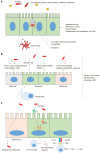Intestinal enteroids/organoids: A novel platform for drug discovery in inflammatory bowel diseases
- PMID: 31435168
- PMCID: PMC6700704
- DOI: 10.3748/wjg.v25.i30.4125
Intestinal enteroids/organoids: A novel platform for drug discovery in inflammatory bowel diseases
Abstract
The introduction of biologics such as anti-tumor necrosis factor (TNF) monoclonal antibodies followed by anti-integrins has dramatically changed the therapeutic paradigm of inflammatory bowel diseases (IBD). Furthermore, a newly developed anti-p40 subunit of interleukin (IL)-12 and IL-23 (ustekinumab) has been recently approved in the United States for patients with moderate to severe Crohn's disease who have failed treatment with anti-TNFs. However, these immunosuppressive therapeutics which focus on anti-inflammatory mechanisms or immune cells still fail to achieve long-term remission in a significant percentage of patients. This strongly underlines the need to identify novel treatment targets beyond immune suppression to treat IBD. Recent studies have revealed the critical role of intestinal epithelial cells (IECs) in the pathogenesis of IBD. Physical, biochemical and immunologic driven barrier dysfunctions of epithelial cells contribute to the development of IBD. In addition, the recent establishment of adult stem cell-derived intestinal enteroid/organoid culture technology has allowed an exciting opportunity to study human IECs comprising all normal epithelial cells. This long-term epithelial culture model can be generated from endoscopic biopsies or surgical resections and recapitulates the tissue of origin, representing a promising platform for novel drug discovery in IBD. This review describes the advantages of intestinal enteroids/organoids as a research tool for intestinal diseases, introduces studies with these models in IBD, and gives a description of the current status of therapeutic approaches in IBD. Finally, we provide an overview of the current endeavors to identify a novel drug target for IBD therapy based on studies with human enteroids/organoids and describe the challenges in using enteroids/organoids as an IBD model.
Keywords: Crohn’s disease; Enteroids; Inflammatory bowel diseases; Organoids; Ulcerative colitis.
Conflict of interest statement
Conflict-of-interest statement: No potential conflicts of interest.
Figures

Similar articles
-
Development, validation and implementation of an in vitro model for the study of metabolic and immune function in normal and inflamed human colonic epithelium.Dan Med J. 2015 Jan;62(1):B4973. Dan Med J. 2015. PMID: 25557335 Review.
-
Organoid Medicine for Inflammatory Bowel Disease.Stem Cells. 2022 Mar 16;40(2):123-132. doi: 10.1093/stmcls/sxab020. Stem Cells. 2022. PMID: 35258629 Review.
-
Application of Human Induced Pluripotent Stem Cell-Derived Intestinal Organoids as a Model of Epithelial Damage and Fibrosis in Inflammatory Bowel Disease.Biol Pharm Bull. 2020;43(7):1088-1095. doi: 10.1248/bpb.b20-00088. Biol Pharm Bull. 2020. PMID: 32612071
-
Enteroids Derived From Inflammatory Bowel Disease Patients Display Dysregulated Endoplasmic Reticulum Stress Pathways, Leading to Differential Inflammatory Responses and Dendritic Cell Maturation.J Crohns Colitis. 2020 Jul 30;14(7):948-961. doi: 10.1093/ecco-jcc/jjz194. J Crohns Colitis. 2020. PMID: 31796949
-
DNA Methylation and Transcription Patterns in Intestinal Epithelial Cells From Pediatric Patients With Inflammatory Bowel Diseases Differentiate Disease Subtypes and Associate With Outcome.Gastroenterology. 2018 Feb;154(3):585-598. doi: 10.1053/j.gastro.2017.10.007. Epub 2017 Oct 12. Gastroenterology. 2018. PMID: 29031501 Free PMC article.
Cited by
-
The translational roadmap of the gut models, focusing on gut-on-chip.Open Res Eur. 2023 Jan 18;1:62. doi: 10.12688/openreseurope.13709.2. eCollection 2021. Open Res Eur. 2023. PMID: 37645178 Free PMC article. Review.
-
Human organoids are superior to cell culture models for intestinal barrier research.Front Cell Dev Biol. 2023 Oct 2;11:1223032. doi: 10.3389/fcell.2023.1223032. eCollection 2023. Front Cell Dev Biol. 2023. PMID: 37849736 Free PMC article.
-
Development of a Limosilactobacillus reuteri therapeutic delivery platform with reduced colonization potential.Appl Environ Microbiol. 2024 Nov 20;90(11):e0031224. doi: 10.1128/aem.00312-24. Epub 2024 Oct 31. Appl Environ Microbiol. 2024. PMID: 39480094 Free PMC article.
-
Development of Colonic Organoids Containing Enteric Nerves or Blood Vessels from Human Embryonic Stem Cells.Cells. 2020 Sep 29;9(10):2209. doi: 10.3390/cells9102209. Cells. 2020. PMID: 33003541 Free PMC article.
-
Interleukin-27 Regulates the Function of the Gastrointestinal Epithelial Barrier in a Human Tissue-Derived Organoid Model.Biology (Basel). 2022 Mar 11;11(3):427. doi: 10.3390/biology11030427. Biology (Basel). 2022. PMID: 35336801 Free PMC article.
References
-
- Okamoto R, Watanabe M. Role of epithelial cells in the pathogenesis and treatment of inflammatory bowel disease. J Gastroenterol. 2016;51:11–21. - PubMed
-
- Frolkis AD, Dykeman J, Negrón ME, Debruyn J, Jette N, Fiest KM, Frolkis T, Barkema HW, Rioux KP, Panaccione R, Ghosh S, Wiebe S, Kaplan GG. Risk of surgery for inflammatory bowel diseases has decreased over time: a systematic review and meta-analysis of population-based studies. Gastroenterology. 2013;145:996–1006. - PubMed
-
- Ruffolo C, Scarpa M, Bassi N. Infliximab, azathioprine, or combination therapy for Crohn's disease. N Engl J Med. 2010;363:1086–1087; author reply 1087-1088. - PubMed
-
- Feagan BG, Sandborn WJ, Gasink C, Jacobstein D, Lang Y, Friedman JR, Blank MA, Johanns J, Gao LL, Miao Y, Adedokun OJ, Sands BE, Hanauer SB, Vermeire S, Targan S, Ghosh S, de Villiers WJ, Colombel JF, Tulassay Z, Seidler U, Salzberg BA, Desreumaux P, Lee SD, Loftus EV, Jr, Dieleman LA, Katz S, Rutgeerts P UNITI–IM-UNITI Study Group. Ustekinumab as Induction and Maintenance Therapy for Crohn's Disease. N Engl J Med. 2016;375:1946–1960. - PubMed
Publication types
MeSH terms
Substances
Grants and funding
LinkOut - more resources
Full Text Sources

